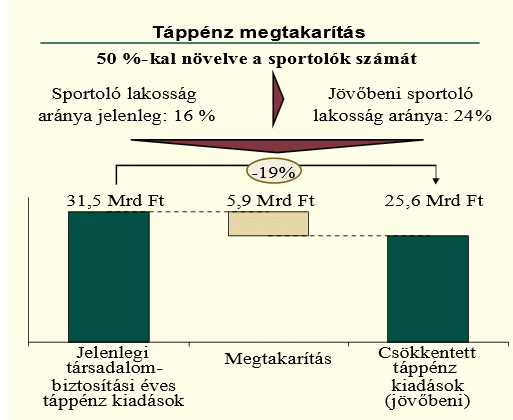I.4. The relationship between nutrition and sports activity
Regular physical activity can be considered as part of culture. It leads – in addition to an aesthetically nice physical appearance – to a well-balanced operation of the body. Its most important result is the high level of physical activity in everyday life, or the person’s excellence in one or another type of sports. Work, artistic achievements, sports and health-illness approve of the above truth.
Nutrition can be seen as part of culture, too, and it is to be in harmony with the qualitative indicators of physical activity. Today in the developed world the sources of nutrition are for granted and this feature is not in harmony with the inherited constraint of storing food. Due to this feature obesity (Wikipédia) has become a problem of growing significance. It is a problem in the life of the younger generation, too. According to the data of a survey, carried out in a group of schoolchildren in Pécs, obesity could be related to 12% of the schoolchildren in 1983-84. By 1993-94 this figure grew to 16%. ( Molnár, 1999). In the United Kingdom in 1996 22% of 6-year olds was found obese (Body Mass Index > 85%. BMI: body weight/height squared = kg/m˛) and 10%- (BMI > 95% ) was overweight. In the group of 15-year old children this figure grew to 31% and 17%. ( Sokol RJ, 2000)
Hungarian indicators are even worse. According to data based on EU surveys Hungary is a leader of obesity-related sicknesses and deaths.
Creating values: work, recreation, Þ health
By WHO figures an individual’s health conditions are largely dependent on lifestyle and customs. (Graph 6.)

Graph 6. Components of health by WHO: inherited features, health care, environmental pollution, lifestyle
The same componets are defined by other researchers differently. Mortality risks in the group of the elderly due to chronic, non-infectious diseases are as follows: 1-lifestyle: 40%; 2- environmental pollution: 15-20%; 3- genetic problems: 20-25%; 4- health care problems: 15%. (Iván László, 2004)
Further conclusions can be drawn when comparing and analyzing the relatedness of the above areas. A comprehensive diagram by Vitrai– Mihalicza (2006) has a special role in the comparative study of the above factors.

Figure 6. Factors, inflcuencing health. Source: József Vitrai – Péter Mihalicza
Health conditions (elektronic version, 2006) http://www.tarsadalomkutatas.hu/kkk.php?TPUBL-A-692/publikaciok/tpubl_a_692.pdf
In this area the most conspicuous feature is the –lack of- physical activity. Responsibilities and interests are shared by the govenment – employer and employee..
Participants in the process of value creation are equally interested in bringing about individual (personal) and community values. The creation of values might be performed through an appropriate utilization of resources. Work can be made efficient by mobilizing all resources.
|
Participants in value creation |
Result of work |
|
Employee |
Self realization, livelihood |
|
Employer |
Making and increasing profit |
|
State |
Realization of social aims from the redistribution of incomes |
Table 3: Work as value-creating activity (author’s own work)
At the same time it needs to be noted that the above ideas, namely that it is not enough to create and keep jobs, but the employees’ recreation also needs to be financed, are not yet very common in Hungary. „Recreation means wellbeing , and serves the aim of living quality life through enlivenment and entertainment.’(Kovács,2007)
In my opinion recreation is a value-creating activity which, similar to work, requires investment.
|
Participants in value-creating activities, investors |
Recreational outcomes,- interests of all the three participants |
|
Employee |
Increased efficiency,: interest and responsibility of the individual |
|
Employer |
High-level exploitation of employees’s knowledge and skills |
|
Government |
Increased income through employer’s and employee’s contributions, reduced health care costs, increasing consumption etc. |
Table 4: Recreation as valuecreating activity (author’s own work)
Outcomes of recreation, as investment:
- Restored and increased working ability
- Increased income
- More leisure time
- Fewer accidents and illnesses
- Reduced number of days spent in sick-leave
- Increased consumption
- Higher quality of life – longer life etc.
Improved performance at work is the result of a better ratio between work and recreation. Improved work performance means that the person creates higher value in a given perod of time, resulting in more free time and increased profits.
As far as the government is concerned an increase in the number of sports people by 8% would mean savings of several billions of forints when considering the number of sick-leave days. .

Figure 7: Savings in the number of sick-leave days . Source: Ács Pongrác–Hécz Roland–Paár Dávid–Stocker Miklós: A fittség (m)értéke, A fizikai inaktivitás nemzetgazdasági terhei Magyarországon, Közgazdasági Szemle, VIII. évf., 2011. July–August (pp 689–708)